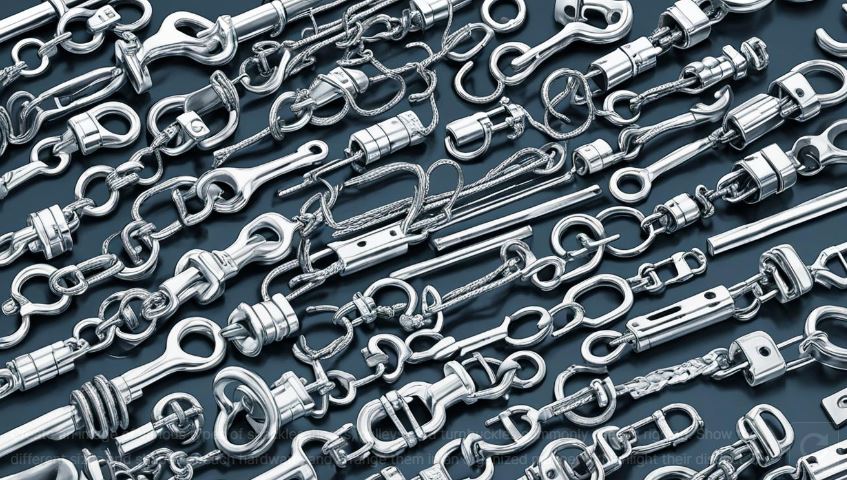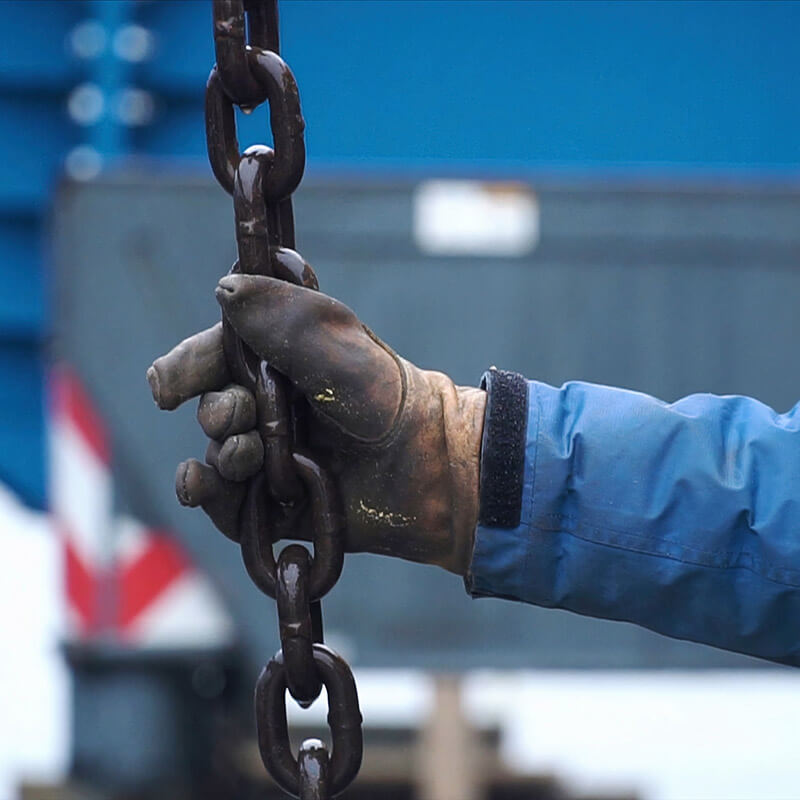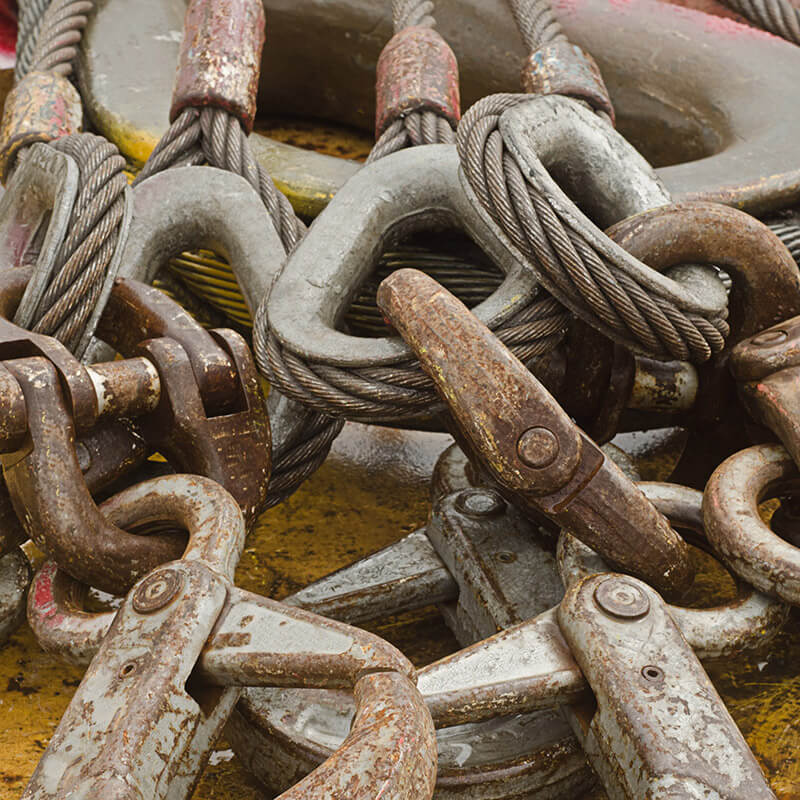What hardware is used in rigging?
Did you know that rigging hardware plays a crucial role in the safe lifting and moving of heavy objects? From construction sites to industrial settings, rigging equipment is essential in ensuring the efficient handling of loads. Whether it's shackles, hooks, slings, eye bolts, or nuts, each component serves a specific purpose in the rigging process.

To understand the importance of rigging hardware and its various applications, let's delve deeper into the world of rigging equipment, exploring the functions of different components and the critical safety measures to follow.
Key Takeaways:
- Rigging hardware is crucial for safe lifting and moving of heavy objects.
- Components like shackles, hooks, slings, eye bolts, and nuts are commonly used in rigging operations.
- Safety measures, such as proper training, regular equipment inspection, and adherence to load limits, are essential for avoiding accidents.
- When selecting rigging hardware, consider working load limits, safety factors, and material and design considerations.
- Rigging hardware is not only used for lifting but also for pulling, towing, lashing, and anchoring.
Understanding Rigging Hardware and Its Functions
In the world of rigging, having the right hardware is crucial for safe and efficient operations. Rigging hardware refers to the equipment specifically designed for lifting and moving heavy loads securely. It encompasses a variety of components, including shackles, hooks, and slings, which play essential roles in the rigging process.
Defining Rigging and Lifting Hardware
Before delving into the functions of rigging hardware, it's important to differentiate between rigging and lifting hardware. Rigging hardware is a broader term that encompasses all the equipment used in rigging operations, such as securing, hoisting, and anchoring loads. On the other hand, lifting hardware is a subset of rigging hardware that is specifically designed for vertical lifting.
Rigging hardware and lifting hardware go hand in hand, with rigging hardware serving as the foundation for lifting hardware to safely lift and move loads vertically. By understanding the distinction between the two, riggers can make informed decisions about the right equipment to use in different rigging scenarios.
Differentiating Between Lifting and Rigging Gear
When it comes to rigging operations, it's crucial to differentiate between lifting gear and rigging gear. Lifting gear primarily focuses on vertical lifting, while rigging gear encompasses a broader range of functions, including lifting, suspending, hoisting, securing, lashing, towing, and anchoring loads.
Rigging gear, which includes various types of rigging hardware, provides the necessary components to safely attach, connect, and maneuver loads during rigging operations. By understanding the functions of rigging gear, riggers can ensure the proper use of equipment and the safe execution of tasks.
By understanding the definitions and distinctions between rigging and lifting hardware and differentiating between lifting and rigging gear, riggers can make informed decisions about the suitable equipment to use in various rigging scenarios. The appropriate selection and utilization of rigging hardware play a vital role in ensuring the safety and success of rigging operations.
Key Rigging Equipment for Safe Load Management
The key rigging equipment plays a crucial role in ensuring safe load management. Understanding the different components and their functions is essential for the successful execution of rigging operations. Let's explore some of the essential rigging equipment used in safe load management:
Shackles, Hooks, and Slings
Shackles, hooks, and slings are pivotal in rigging operations as they provide the necessary connections and support for lifting heavy loads securely:
- Shackles: Shackles are used to connect lifting chains or wire ropes to the load being lifted. They are designed to withstand heavy loads while ensuring a reliable and secure connection.
- Hooks: Hooks serve as attachment points for lifting and suspending loads. They come in various shapes and designs, such as clevis hooks and grab hooks, to accommodate different rigging needs.
- Slings: Slings are flexible straps or chains used to support and lift heavy objects. They distribute the load evenly, minimizing the risk of damage to the load and ensuring a safer lifting operation.
These rigging components work together to create a robust and reliable lifting system, allowing for efficient load management.
Eye Bolts and Nuts Essentials
Eye bolts and nuts are essential for attaching rigging components to the load or lifting equipment. They provide a secure and stable connection:
- Eye Bolts: Eye bolts feature a looped bolt for attaching hooks, slings, or other rigging hardware. They are available in various sizes and designs, including shoulder eye bolts and forged eye bolts, catering to different load requirements.
- Nuts: Nuts are threaded fasteners that secure the eye bolts in place. They ensure a tight connection and prevent any accidental disengagement during the lifting process.
The utilization of these key rigging equipment components ensures the safe and efficient management of loads during rigging operations. Their proper selection and use contribute to a secure lifting system and minimize the risk of accidents or damage to the load and surrounding environment.
Critical Safety Measures for Rigging Operations
Rigging operations involve potential risks and hazards, making safety measures crucial. It is important to follow safety regulations and guidelines to ensure the safety of operators and prevent accidents. To maintain rigging safety, several critical safety measures should be implemented:
- Proper training and certification of riggers: Rigging operations require skilled personnel who are trained in safe rigging practices. Riggers should undergo comprehensive training programs and obtain the necessary certifications to ensure they have the knowledge and skills to perform rigging tasks safely.
- Regular inspection of rigging equipment: Rigging equipment should be inspected regularly to identify any signs of wear, damage, or defects. This includes checking shackles, hooks, slings, and other components for cracks, deformations, or excessive wear. If any issues are discovered, the equipment should be repaired or replaced before further use.
- Adherence to load limits and safety factors: Rigging operations involve lifting and moving heavy loads, so it is crucial to adhere to load limits specified by manufacturers. Exceeding the load limits can put undue stress on the rigging hardware, increasing the risk of failure. Safety factors should also be considered to provide an additional margin of safety.
- Maintaining a safe work environment: Creating a safe work environment is essential for rigging operations. This includes keeping the work area clear of obstacles, providing adequate lighting, and implementing proper communication protocols. Regular safety meetings and safety reminders can also help reinforce safe practices among rigging personnel.
By implementing these critical safety measures, rigging operations can be carried out with a reduced risk of accidents and injuries. Rigging safety should always be a top priority to protect the well-being of operators and ensure the success of rigging operations.
How to Determine the Right Rigging Hardware for Your Project
When undertaking a rigging project, selecting the appropriate rigging hardware is essential to ensure the safety and success of the operation. Several factors need to be considered in this decision-making process, including working load limits (WLL) and safety factors, as well as material and design considerations.
Working Load Limits (WLL) and Safety Factors
The working load limit (WLL) is a crucial factor to consider when determining the right rigging hardware for your project. The WLL refers to the maximum weight that the hardware can safely support. It is important to carefully assess the weight of the load being lifted or moved and choose rigging hardware that has a sufficient WLL to handle the load without compromising safety.
Additionally, safety factors provide an added margin of error and account for uncertainties and variables that may arise during the rigging operation. Safety factors are typically expressed as a ratio, such as 4:1 or 5:1, and they ensure that the rigging hardware can withstand unexpected loads or external forces.
Material and Design Considerations for Rigging Tools
Another critical aspect in determining the right rigging hardware is considering the material and design of the tools. The choice of materials, such as stainless steel or carbon steel, can significantly impact the durability, strength, and corrosion resistance of the hardware. It is important to select materials that are appropriate for the specific application and environmental conditions.
The design of the rigging tools also plays a vital role in their performance and reliability. Well-designed hardware should have features that enhance safety and ease of use, such as secure locking mechanisms, smooth load-bearing surfaces, and clear load ratings.
To make an informed decision about the rigging hardware for your project, it is advisable to consult with rigging professionals or engineers who can provide expert guidance based on the specific requirements and conditions of your project. They can help you determine the appropriate working load limits, safety factors, as well as the most suitable materials and design features for your rigging hardware needs.
Rigging Hardware for Pulling, Towing, Lashing, and Anchoring
Rigging hardware is not only essential for lifting operations but also finds applications in pulling, towing, lashing, and anchoring. Different types of rigging hardware are specifically designed for these purposes to ensure safe and reliable operations. These include hooks, chains, turnbuckles, and wire rope fittings.
When it comes to pulling heavy loads, rigging hardware such as hooks equipped with appropriate load ratings are used to securely attach the load to the pulling equipment. For towing purposes, sturdy chains and hooks capable of withstanding the load's weight and forces during transportation are employed.
In lashing applications, rigging hardware such as turnbuckles and wire rope fittings are used to secure and tighten the load to prevent shifting or movement during transit. This hardware ensures that the load remains firmly in place throughout the journey, enhancing safety.
For anchoring purposes, rigging hardware like anchors and anchor chains are utilized to provide a secure and stable base for structures, vessels, or equipment. This hardware is designed to withstand the forces and ensure the stability and positioning of the anchor point.
By selecting the appropriate rigging hardware for each specific application, operators can ensure the safety and efficiency of pulling, towing, lashing, and anchoring operations. It is crucial to consider factors such as load capacity, strength, and compatibility with the equipment being used, to ensure optimal performance and minimize the risk of accidents or failures.
Wrapping up
Rigging hardware plays a crucial role in ensuring the safe and efficient lifting and moving of heavy objects. By understanding the different types of rigging hardware, their functions, and safety considerations, operators can effectively manage load operations and mitigate potential risks.
Following proper rigging practices and adhering to safety regulations are essential for the success of rigging operations. Rigging professionals must undergo proper training and certification to ensure they have the necessary skills and knowledge to handle rigging hardware correctly. Regular inspection and maintenance of rigging equipment are also critical to identify any potential issues and prevent accidents.
Using the right rigging hardware for each specific project is crucial. Consider factors such as working load limits, safety factors, material considerations, and design features when determining the appropriate rigging hardware to use. By doing so, operators can ensure the utmost safety and reliability in their rigging operations.
If you need help from our experienced team in the rigging industry check out our site where you can easily buy directly online as we keep all our inventory in stock with the best pricing on all types of rigging hardware, equipment and supplies.
What Is a Lifting Chain?
Jun 26th 2025
What is Considered Rigging Hardware?
Jun 20th 2025
What Tools Are Needed for Rigging?
Jun 18th 2025
What Equipment Does an Arborist Use?
Jun 13th 2025
What Is the Difference Between a Jib Crane and a Davit?
Jun 9th 2025
What Are the Types of Lifting Equipment?
May 30th 2025
How to Choose the Right Fall Protection Harness?
May 23rd 2025
Which Wire Rope is Stronger: 7x7 or 7x19?
May 20th 2025
How Strong Are Wire Rope Clamps?
May 12th 2025










